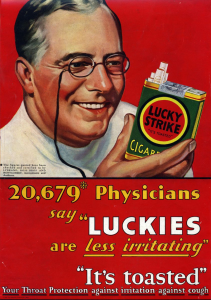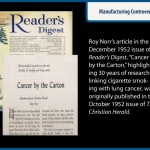Throughout the late 19th century, and the first few decades of the 20th century, smoking was an extremely popular American pastime, as the “cigarette was a cultural icon of sophistication, glamour and sexual allure.”[1] During this era, the American public was bombarded with an overwhelming number of advertisements that positioned cigarettes as vital consumer items. While individuals were anxious and nervous about the risks of smoking, the “negative health effects of tobacco were not initially known,”[2] and tobacco manufacturers attempted to alleviate such concerns by incorporating doctor images to “assure the consumer that their respective brands were safe.”[3] Tobacco manufacturers may have been well aware of the health risks associated with their products, yet without substantial evidence and research, these firms continued to profit from significant cigarette consumption throughout the 20th century.

This era (1880-1930) was ultimately a time where consumers were grossly uninformed and uneducated regarding the countless negative health effects of cigarette smoking. Various European studies previously analyzed the “causal relationship between smoking and cancer,”[4] yet it wasn’t until 1944 that the “American Cancer Society began to warn about possible ill effects of smoking.”[5] Unfortunately, the American Cancer Society lacked conclusive evidence that could outright prove the link between smoking and various forms of cancer and disease.
In the 1950s, the prevalence of literature related to the dangers of smoking began to increase, as smoking was “first linked to several kinds of cancer”[6]. A 1952 Reader’s Digest article titled “Cancer by the Carton” was a groundbreaking study that further enlightened consumers about the health effects of smoking, and caused cigarettes sales to decline “for the first time in over two decades.”[7] In an attempt to protect future profitability, and to ensure that consumers continue buying their products, cigarette manufacturers introduced narratives, images, and slogans in new advertisement campaigns that marketed cigarettes as healthy products that were even consumed by physicians. However, these campaigns were short-lived and unsustainable as “physician images in advertisements were no longer credible in the face of growing public concern about the health evidence implicating cigarettes.”[8] R.J. Reynolds initiated a campaign for their Camel cigarettes brand in January 1946 that featured the slogan “More doctors smoke Camels than any other cigarette,” but the continued “use of physicians in Camel advertisements could not be sustained as the health evidence against cigarettes accumulated.”[9] Philip Morris was another prominent cigarette manufacturer that featured statistics and themes centered on the medical profession’s support of cigarette consumption.
For the first half of the 1900s, cigarette consumption had steadily increased due to inadequate regulation, aggressive marketing campaigns, and a lack of knowledge related to health risks. By 1963, the average American smoked 4,345 cigarettes per year.[10] Unfortunately, it took the majority of the 20th century to realize how dangerous cigarettes are for our health. The formation of the Surgeon General’s Advisory Committee on Smoking and Health (1964) represented a monumental step towards understanding and publicizing the true health impacts of smoking. Through extensive research, the committee released a 387-page report concluding, “that cigarette smoking is causally related to lung cancer in men.”[11] Over time, Surgeon General’s reports strengthened the case against smoking, and by 1981, they confirmed, “no level of cigarette smoking is safe.”[12]
Paired with enhanced regulation that prohibited cigarette advertisement on radio and television and banned smoking on commercial flights, the growth of research and evidence related to the effects of smoking was instrumental in educating the American public about the dangers of tobacco use. Today, there are no doubts that cigarette smoking “harms nearly every organ of the body.”[13] While “nearly half of all living adults who ever smoked have quit,”[14] there is still a large percentage of the American population that still smokes (45 million adults).
[1] Markel, Howard. “Tracing the Cigarette’s Path from Sexy to Deadly.” The New York Times 20 Mar. 2007: n. pag. Print.
[2] “A Brief History of Tobacco.” CNN. Cable News Network, n.d. Web.
[3] Gardner, Martha N., and Allan M. Brandt. “”The Doctor’s Choice Is America’s Choice”: The Physician in US Cigarette Advertisements, 1930-1953.” American Journal of Public Health 96.2 (2006): 222-32. Web.
[4] [5] [7] “A Brief History of Tobacco.” CNN. Cable News Network, n.d. Web.
[6] Grob, George. “Major Tobacco-Related Events in the United States.” RWJF Retrospective Series (2011): 1-14. Web.
[8] [9] Gardner, Martha N., and Allan M. Brandt. “”The Doctor’s Choice Is America’s Choice”: The Physician in US Cigarette Advertisements, 1930-1953.” American Journal of Public Health 96.2 (2006): 222-32. Web.
[10] Grob, George. “Major Tobacco-Related Events in the United States.” RWJF Retrospective Series (2011): 1-14. Web.
[11] “A Brief History of Tobacco.” CNN. Cable News Network, n.d. Web.
[12] Grob, George. “Major Tobacco-Related Events in the United States.” RWJF Retrospective Series (2011): 1-14. Web.
[13] “Health Effects of Cigarette Smoking.” Centers for Disease Control and Prevention. Centers for Disease Control and Prevention, 06 Feb. 2014. Web. <http://www.cdc.gov/tobacco/data_statistics/fact_sheets/health_effects/effects_cig_smoking/>.
[14] “History of the Surgeon General’s Reports on Smoking and Health.” Centers for Disease Control and Prevention. Centers for Disease Control and Prevention, 06 July 2009. Web. <http://www.cdc.gov/tobacco/data_statistics/sgr/history/>.


